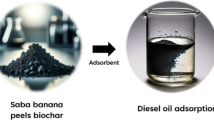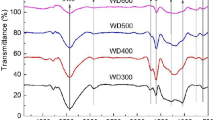Abstract
The biochar pyrolyzed from the sludge is porous and non-polar and can be used as an adsorbent for polycyclic aromatic hydrocarbon (PAH) pollutants. However, the adsorption process and effect of biochar on the widespread mixed petroleum hydrocarbon pollutants (including saturated hydrocarbons, resins, aromatic hydrocarbons and asphaltenes, etc.) are not thoroughly revealed. Among diverse treatment technologies, pyrolysis can effectively achieve the reduction of the excess sludge and obtain biochar. The characteristics of biochar are inseparably bound to the pyrolysis temperature. The physicochemical properties of biochar obtained from excess sludge which was pyrolyzed at different temperatures (300–900 °C) and the performance of it in absorbing actual ground crude oil were investigated in this study. The results showed that as the pyrolysis temperature increased, the polarity of biochar decreased, and the honeycomb or layered structure containing plenty of micropores appeared. The petroleum hydrocarbons’ removal efficiency of biochar with the pyrolysis temperature of 700℃ was up to 96.01%, which was the highest among all biochar. In addition, the leaching test showed that only four metal ions were detected, of which the highest concentration was 4.78 × 10−2 mg/g of K+. It indicated that the biochar derived from excess sludge was expected to become environment friendly materials to avoid soil pollution during the process of oil extraction and processing. This study provided new sights for the treatment of excess sludge and the application of the produced biochar.





Similar content being viewed by others
Data availability
The datasets used in the current study are available from the corresponding author on reasonable request.
References
Sheik AR, Muller EEL, Wilmes P (2014) A hundred years of activated sludge: time for a rethink. Front Microbiol 5:1–7
Meng XZ, Venkatesan AK, Ni YL, Steele JC, Wu LL, Bignert A, Bergman A, Halden RU (2016) Organic contaminants in Chinese sewage sludge: a meta-analysis of the literature of the past 30 years. Environ Sci Technol 50(11):5454–5466
Peccia J, Westerhoff P (2015) We should expect more out of our sewage sludge. Environ Sci Technol 49(14):8271–8276
Callegari A, Capodaglio, Giuseppe AJR (2018) Properties and beneficial uses of (bio)chars, with special attention to products from sewage sludge pyrolysis. Resources 7(1):1–22
Tyagi VK, Lo SL (2013) Sludge: a waste or renewable source for energy and resources recovery? Renew Sust Energ Rev 25:708–728
Fonts I, Gea G, Azuara M, Abrego J, Arauzo J (2012) Sewage sludge pyrolysis for liquid production: a review. Renew Sust Energ Rev 16(5):2781–2805
Hao XD, Chen Q, van Loosdrecht MCM, Li J, Jiang H (2020) Sustainable disposal of excess sludge: incineration without anaerobic digestion. Water Res 170(1):115298
Shi S, Xu GR, Yu HR, Zhang Z (2018) Strategies of valorization of sludge from wastewater treatment. J Chem Technol Biot 93(4):936–944
Huang HJ, Yuan XZ (2016) The migration and transformation behaviors of heavy metals during the hydrothermal treatment of sewage sludge. Bioresource Technol 200:991–998
Racek J, Sevcik J, Chorazy T, Kucerik J, Hlavinek P (2020) Biochar - recovery material from pyrolysis of sewage sludge: a review. Waste Biomass Valori 11(7):3677–3709
Chen YD, Wang RP, Duan XG, Wang SB, Ren NQ, Ho SH (2020) Production, properties, and catalytic applications of sludge derived biochar for environmental remediation. Water Res 187:116390
Gopinath A, Divyapriya G, Srivastava V, Laiju AR, Nidheesh PV, Kumar MS (2021) Conversion of sewage sludge into biochar: a potential resource in water and wastewater treatment. Environ Res 194:110656–110656
Ahmed MB, Zhou JL, Ngo HH, Guo WS (2016) Insight into biochar properties and its cost analysis. Biomass Bioenerg 84:76–86
Vilas-Boas ACM, Tarelho LAC, Kamali M, Hauschild T, Pio DT, Jahanianfard D, Gomes APD, Matos MAA (2021) Biochar from slow pyrolysis of biological sludge from wastewater treatment: characteristics and effect as soil amendment. Biofuel Bioprod Bior 15(4):1054–1072
Dike CC, Shahsavari E, Surapaneni A, Shah K, Ball AS (2021) Can biochar be an effective and reliable biostimulating agent for the remediation of hydrocarbon-contaminated soils? Environ Int 154:106553
Varjani SJ, Upasani VN (2017) A new look on factors affecting microbial degradation of petroleum hydrocarbon pollutants. Int Biodeter Biodegr 120:71–83
Das SK, Ghosh GK, Avasthe RK, Sinha K (2021) Compositional heterogeneity of different biochar: effect of pyrolysis temperature and feedstocks. J Environ Manage 278(Pt 2):111501
Chen BL, Zhou DD, Zhu LZ (2008) Transitional adsorption and partition of nonpolar and polar aromatic contaminants by biochars of pine needles with different pyrolytic temperatures. Environ Sci Technol 42(14):5137–5143
Yang K, Yang JJ, Jiang Y, Wu WH, Lin DH (2016) Correlations and adsorption mechanisms of aromatic compounds on a high heat temperature treated bamboo biochar. Environ Pollut 210:57–64
Jamieson T, Sager E, Gueguen C (2014) Characterization of biochar-derived dissolved organic matter using UV-visible absorption and excitation-emission fluorescence spectroscopies. Chemosphere 103:197–204
Mukherjee A, Zimmerman AR, Harris W (2011) Surface chemistry variations among a series of laboratory-produced biochars. Geoderma 163(3–4):247–255
Xiao X, Chen BL, Chen ZM, Zhu LZ, Schnoor JL (2018) Insight into multiple and multilevel structures of biochars and their potential environmental applications: a critical review. Environ Sci Technol 52(9):5027–5047
Xu YL, Chen BL (2013) Investigation of thermodynamic parameters in the pyrolysis conversion of biomass and manure to biochars using thermogravimetric analysis. Bioresource Technol 146:485–493
Jin JW, Li YN, Zhang JY, Wu SC, Cao YC, Liang P, Zhang J, Wong MH, Wang MY, Shan SD, Christie P (2016) Influence of pyrolysis temperature on properties and environmental safety of heavy metals in biochars derived from municipal sewage sludge. J Hazard Mater 320:417–426
Wang XL, Cook R, Tao S, Xing BS (2007) Sorption of organic contaminants by biopolymers: role of polarity, structure and domain spatial arrangement. Chemosphere 66(8):1476–1484
Zheng H, Wang ZY, Zhao J, Herbert S, Xing BS (2013) Sorption of antibiotic sulfamethoxazole varies with biochars produced at different temperatures. Environ Pollut 181:60–67
Li HB, Dong XL, da Silva EB, de Oliveira LM, Chen YS, Ma LNQ (2017) Mechanisms of metal sorption by biochars: biochar characteristics and modifications. Chemosphere 178:466–478
Aktar S, Hossain MA, Rathnayake N, Patel S, Gasco G, Mendez A, de Figueiredo C, Surapaneni A, Shah KL, Paz-Ferreiro J (2022) Effects of temperature and carrier gas on physico-chemical properties of biochar derived from biosolids. J Anal Appl Pyrol 164:105542
Pulka J, Manczarski P, Stpień P, Styczyńska M, Biaowiec AJM (2020) Waste-to-carbon: is the torrefied sewage sludge with high ash content a better fuel or fertilizer? Materials 13(4):954
Ghanim BM, Pandey DS, Kwapinski W, Leahy JJ (2016) Hydrothermal carbonisation of poultry litter: effects of treatment temperature and residence time on yields and chemical properties of hydrochars. Bioresource Technol 216:373–380
Krevelen DJF (1950) Graphical-statistical method for the study of structure and reaction processes of coal. Fuel 29:269–284
Kim D, Lee K, Park KY (2014) Hydrothermal carbonization of anaerobically digested sludge for solid fuel production and energy recovery. Fuel 130:120–125
Konczak M, Oleszczuk P, Rozylo K (2019) Application of different carrying gases and ratio between sewage sludge and willow for engineered (smart) biochar production. J Co2 Util 29:20–28
Spokas KA, Novak JM, Masiello CA, Johnson MG, Colosky EC, Ippolito JA, Trigo C (2014) Physical disintegration of biochar: an overlooked process. Environ Sci Tech Let 1(8):326–332
Hossain MK, Strezov V, Chan KY, Ziolkowski A, Nelson PF (2011) Influence of pyrolysis temperature on production and nutrient properties of wastewater sludge biochar. J Environ Manage 92(1):223–228
Lu HL, Zhang WH, Wang SZ, Zhuang LW, Yang YX, Qiu RL (2013) Characterization of sewage sludge-derived biochars from different feedstocks and pyrolysis temperatures. J Anal Appl Pyrol 102:137–143
Baldock JA, Smernik RJ (2002) Chemical composition and bioavailability of thermally, altered Pinus resinosa (red pine) wood. Org Geochem 33(9):1093–1109
Demirbas A (2004) Effects of temperature and particle size on bio-char yield from pyrolysis of agricultural residues. J Anal Appl Pyrol 72(2):243–248
Varjani SJ (2017) Microbial degradation of petroleum hydrocarbons. Bioresource Technol 223:277–286
Guo W, Ai Y, Men B, Wang S (2017) Adsorption of phenanthrene and pyrene by biochar produced from the excess sludge: experimental studies and theoretical analysis. Int J Environ Sci Te 14(9):1889–1896
Zhu SS, Huang XC, Ma F, Wang L, Duan XG, Wang SB (2018) Catalytic removal of aqueous contaminants on N-doped graphitic biochars: inherent roles of adsorption and nonradical mechanisms. Environ Sci Technol 52(15):8649–8658
Valizadeh S, Lee SS, Choi YJ, Baek K, Jeon BH, Lin KYA, Park YK (2022) Biochar application strategies for polycyclic aromatic hydrocarbons removal from soils. Environ Res 213:113599
Bianco F, Race M, Papirio S, Oleszczuk P, Esposito G (2021) The addition of biochar as a sustainable strategy for the remediation of PAH-contaminated sediments. Chemosphere 263:128274
vom Eyser C, Palmu K, Schmidt TC, Tuerk J (2015) Pharmaceutical load in sewage sludge and biochar produced by hydrothermal carbonization. Sci Total Environ 537:180–186
Fang SE, Tsang DCW, Zhou FS, Zhang WH, Qiu RL (2016) Stabilization of cationic and anionic metal species in contaminated soils using sludge-derived biochar. Chemosphere 149:263–271
Liang LP, Xi FF, Tan WS, Meng X, Hu BW, Wang XK (2021) Review of organic and inorganic pollutants removal by biochar and biochar-based composites. Biochar 3(3):255–281
Chen W, Westerhoff P, Leenheer JA, Booksh K (2003) Fluorescence excitation - Emission matrix regional integration to quantify spectra for dissolved organic matter. Environ Sci Technol 37(24):5701–5710
Zielinska A, Oleszczuk P, Charmas B, Skubiszewska-Zieba J, Pasieczna-Patkowska S (2015) Effect of sewage sludge properties on the biochar characteristic. J Anal Appl Pyrol 112:201–213
Yuan HR, Lu T, Huang HY, Zhao DD, Kobayashi N, Chen Y (2015) Influence of pyrolysis temperature on physical and chemical properties of biochar made from sewage sludge. J Anal Appl Pyrol 112:284–289
Cai Z, Wang B, Xu M, Zhang H, He X, Zhang L, Gao S (2014) Intensified soil acidification from chemical N fertilization and prevention by manure in an 18-year field experiment in the red soil of southern China. J Soils Sediments 15(2):260–270
Godlewska P, Ok YS, Oleszczuk P (2021) THE DARK SIDE OF BLACK GOLD: Ecotoxicological aspects of biochar and biochar-amended soils. J Hazard Mater 403:123833
Funding
This study was funded by the National Key Research and Development Program of China (2020YFC1807100), the National Natural Science Foundation of China (No. 42077213), and the National Water Pollution Control and Treatment Science and Technology Major Project of China (2017ZX07402002-04).
Author information
Authors and Affiliations
Contributions
Chunli Wan and Changyong Wu designed study. Qin An and Guangmin Liu collected samples and conducted experiments. Liyan Deng and Liya Fu analyzed and visualized data. Yue Wang contributed to data interpretation. Changyong Wu wrote the manuscript with contributions from all co-authors.
Corresponding authors
Ethics declarations
Ethical approval
Not applicable. The study has no data collected from human subjects.
Conflict of interests
The authors declare no competing interests.
Additional information
Publisher's note
Springer Nature remains neutral with regard to jurisdictional claims in published maps and institutional affiliations.
Rights and permissions
Springer Nature or its licensor (e.g. a society or other partner) holds exclusive rights to this article under a publishing agreement with the author(s) or other rightsholder(s); author self-archiving of the accepted manuscript version of this article is solely governed by the terms of such publishing agreement and applicable law.
About this article
Cite this article
Deng, L., Wu, C., Fu, L. et al. Preparation of biochar and its adsorbing performance evaluation in the petroleum hydrocarbon. Biomass Conv. Bioref. (2022). https://doi.org/10.1007/s13399-022-03439-4
Received:
Revised:
Accepted:
Published:
DOI: https://doi.org/10.1007/s13399-022-03439-4




